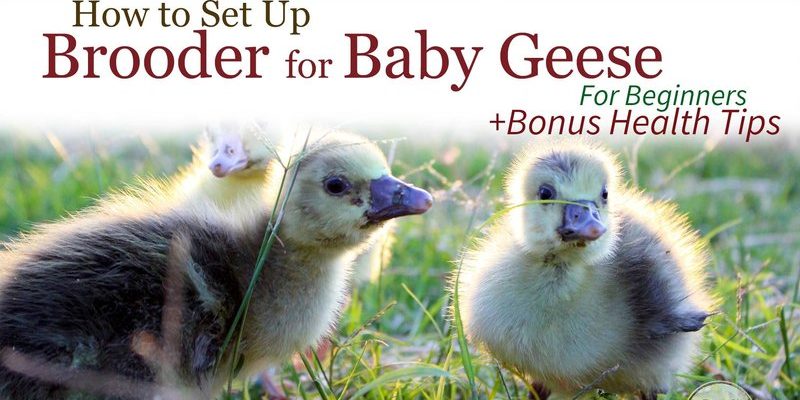
Raising goslings offers more than just that warm fuzzy feeling. It’s also an opportunity to connect with nature and understand the responsibilities of animal care. Whether you’re looking to raise them for companionship, eggs, or just to enjoy their quirky personalities, you’ll want to start off on the right foot. Let’s dive into some essential tips for raising goslings so you can provide the best care possible for your new feathered friends!
Setting Up a Safe Home for Goslings
Before bringing home your goslings, you’ll need to create a safe and comfortable space for them. Think of it like setting up a cozy nursery for a baby. Goslings need warmth, shelter, and space to explore. A brooder is usually the best setup for these little ones. It can be a large cardboard box or a designated area in your garage or barn.
Ensure the brooder maintains a cozy temperature of around 90°F (32°C) for the first week, gradually reducing it by about 5°F each week until they’re fully feathered. You can use heat lamps for warmth, but be careful; they can get pretty hot! Here’s what you’ll want to include in your brooder setup:
- Deep bedding: Use straw or wood shavings to absorb moisture and provide comfort.
- Water source: Goslings love to splash, so provide shallow dishes with fresh water.
- Food: Start with a high-quality gosling starter feed to promote growth.
By creating this safe haven, you’re setting the stage for happy, healthy goslings.
Feeding Your Goslings Properly
Feeding goslings isn’t just about tossing them some seeds and calling it a day. It’s more like balancing a diet for a growing child. Goslings need a special diet rich in protein to support their rapid growth. Look for commercial gosling starter feed, which typically contains around *18-20% protein*. This is crucial in the early stages of their life.
For the first few weeks, your goslings should have access to feed 24/7. After a week, you can introduce greens like lettuce, peas, or even dandelion leaves. Just remember to chop them into small pieces so they don’t choke. Over time, you can slowly transition to a mix of grains and greens, but never forget their starter feed is vital during growth.
You might be wondering how often to feed them. Generally, goslings eat a lot! Make sure to refill food and water daily, and check for any waste. Keeping their feeding area clean is important not only for their health but also for preventing any unwanted odors.
Understanding the Social Needs of Goslings
Goslings are social creatures, and raising them in groups is ideal. They’re like little kids—having friends matters! If you only get one gosling, they can become lonely and stressed. Ideally, you should have at least two goslings to keep each other company.
During their early weeks, spend time with them daily. They’ll bond with you and become more comfortable around humans. You might even notice them following you like little ducklings! This interaction helps with their social development, allowing them to grow up confident and friendly.
Be aware that goslings might peck at one another as they establish their pecking order. While this is normal behavior, ensure that none of them are being bullied, as it can lead to stress and injury. If you notice aggression, you may need to separate them temporarily until things calm down.
Water Needs: The Importance of Splashing Around
If there’s one thing goslings love, it’s water! While they don’t need a pond to thrive, providing a shallow water dish for splashing and drinking is essential. Water not only keeps them hydrated but also promotes their natural behaviors, like preening their feathers.
Make sure the water source is clean and changed daily. You don’t want stagnant water, as it can lead to health issues. It’s also a good idea to keep the water dish shallow so they don’t accidentally drown. Adding some rocks in the dish can help them gauge their depth, making it safer for these little explorers.
If you have access to a small kiddie pool once they get a bit older and more coordinated, that can be a fun treat! Just supervise them, and ensure they can easily get in and out.
Keeping Goslings Healthy: Common Health Issues
Just like any young animal, goslings can face health challenges. Being proactive can make a big difference in their well-being. Some common issues include pasty butt, which is when droppings get stuck to their bottoms, leading to blockage. If you spot this, gently clean the area with warm water to prevent complications.
Another potential issue is nutritional deficiencies, which can arise if they don’t receive the right feed. Monitor their growth closely and consult a vet if you notice anything unusual, like lethargy or poor feather development. Also, be mindful of their surroundings; goslings can be susceptible to cold temperatures and drafts, so keep their living area warm and sheltered.
Regularly checking their health and providing a clean environment will help keep your goslings thriving.
Transitioning to Outdoor Living
As your goslings grow and develop their feathers, it’ll soon be time for them to experience the great outdoors. But transitioning from a brooder to the outside world requires some planning. Start by letting them explore a secure, small outdoor area for short periods, gradually increasing the time as they become more comfortable.
Make sure the environment is safe from predators. A fenced area with adequate shade, food, and water is ideal. You might also want to introduce them to the grass, as it’s a natural part of their diet and allows them to forage and explore. Monitor them closely during these first outdoor adventures, as they’re still quite young and can be easily startled.
Moving them outside is a big step—much like sending your kids off to school. They’ll have more freedom and learn essential skills, but your watchful eye will still be needed as they adapt.
Enjoying the Journey of Raising Goslings
Raising goslings is more than just a hobby; it’s an experience filled with laughter, learning, and a few challenges along the way. As you nurture them, you’ll find joy in their antics and a sense of pride in watching them grow. Remember that patience is key—just like parenting small kids.
So, gather your supplies, prepare your space, and dive into the rewarding world of goslings. You’ll not only enrich their lives but also your own, adding a little more joy to your days.
In the end, raising goslings isn’t just about providing food and shelter; it’s about fostering a connection with these unique creatures and enjoying the journey every step of the way.

